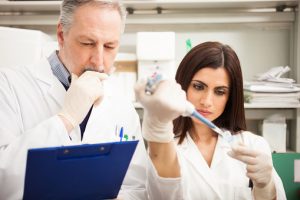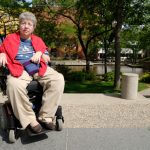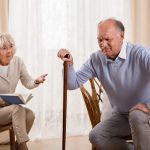 Researchers have uncovered that the retriggering of human endogenous retroviral genes (HERVs) could lead to the development of amyotrophic lateral sclerosis (ALS), suggesting antiretroviral drugs may aid in treatment.
Researchers have uncovered that the retriggering of human endogenous retroviral genes (HERVs) could lead to the development of amyotrophic lateral sclerosis (ALS), suggesting antiretroviral drugs may aid in treatment.
ALS is a progressive neurodegenerative disease which affects the nerve cells in the brain and spinal cord. It is also characterized by the breakdown of muscles, so people with ALS lose their ability to move. Motor neurons die off, and the ability to move and speak diminishes until eventually the individual is unable to function.
Advertisement
Up to 95 percent of ALS cases are sporadic ALS, meaning it can affect anyone, anywhere. Five to 10 percent of ALS cases are familial, meaning the disease is inherited. This increases the risk of a patient’s offspring developing ALS by 50 percent.
New research suggests that the use of antiretroviral drugs may be useful in the treatment of ALS as previous research uncovered the role retroviral genes play in the disease.
Details about the study
 Brain samples from ALS patients revealed high levels of messenger RNA encoded in HERV-K. This was not seen in individuals without ALS but who had Alzheimer’s disease. When activated in a Petri dish, the genes killed human neurons.
Brain samples from ALS patients revealed high levels of messenger RNA encoded in HERV-K. This was not seen in individuals without ALS but who had Alzheimer’s disease. When activated in a Petri dish, the genes killed human neurons.
Researchers then wanted to test their findings on animals, so they altered mice and activated the HERV-K gene. Not only did the mice portray similar movements to ALS, but they died faster as well. By examining the dead mice, researchers found damaged cells in the motor neurons in the brain, spinal cord, and muscles.
Dr. Avindra Nath from the NIH’s National Institute of Neurological Disorders and Stroke said, “We showed that motor neurons may be susceptible to activation of these genes during ALS. We may have discovered a precision medicine solution for treating a neurodegenerative disorder.”
The research team will now go ahead and work with the team over at Johns Hopkins University to test treatments commonly used on HIV patients as potential methods to treat those with ALS.
Amyotrophic lateral sclerosis (ALS) and its classification
You may be somewhat familiar with ALS due to the great amount of attention it received in the summer of 2014 (everyone was dumping ice buckets on themselves). Not only did the campaign raise money for the disease, but it created a great amount of awareness and finally got people talking about this debilitating disease.
Due to the varying symptoms, it can be quite complicated to diagnose ALS. For this reason, doctors have different classifications for ALS.
Classical ALS: Occurs in more than two-thirds of ALS patients. A progressive neurodegenerative disease which affects the nerve cells in the brain and spinal cord.
Primary lateral sclerosis (PLS): Similar to classical ALS, but if the lower motor neurons are not affected within two years it remains an upper motor neuron disease. This is a rare form of ALS.
Progressive bulbar palsy (PBP): Begins with difficulty swallowing, chewing or speaking. PBP affects nearly 25 percent of ALS patients.
Progressive muscular atrophy (PMA): Lower motor neurons deteriorate and if upper motor neurons do not become affected within two years, it remains a lower motor neuron disease.
Familial: ALS is present in one family member and is passed down to another. This can occur in 50 percent of the offspring of those with ALS. Less than 10 percent of ALS cases are familial.
Common causes, risk factors and symptoms of ALS
ALS can either be inherited – in a small amount of cases – or result from gene mutations, chemical imbalance, protein mishandling and disorganized immune response.
The majority of risk factors contributing to ALS are unchangeable. They include genes, age (being over the age of 40), and gender (men have higher cases of ALS prior to the age of 70). Other risk factors include smoking, lead exposure and serving time in the military. Some studies suggest a correlation between military service and an increased risk of ALS, although the research is still unclear.
- Difficulty walking, standing, frequent tripping or difficulty carrying out daily tasks
- Weakness in legs, feet or ankles
- Hand weakness or clumsiness
- Slurring of speech or trouble swallowing
- Muscle cramps or twitching
- Difficulty keeping good posture or keeping your head up
Diagnosis and treatment of ALS
ALS is diagnosed with an electromyogram (EMG) administered by a neurologist. An EMG is able to detect nerve damage. Other tests will determine the cause of other symptoms, such as multiple sclerosis, muscular dystrophy, spinal cord tumors and other diseases.
There is currently no cure for ALS, but treatments are available to minimize symptoms and make living daily life easier. Treatments for ALS include:
 Rilutek: A medication which appears to prevent damage from overexcited nerves. There are potential side effects on the liver, so it’s important to have the watchful eye of a doctor while using this medication.
Rilutek: A medication which appears to prevent damage from overexcited nerves. There are potential side effects on the liver, so it’s important to have the watchful eye of a doctor while using this medication.
Physical therapy: This can help boost circulation and prolong muscle use.
Baclofen: A medication to aid in stiffness.
Nutritional supplements: To promote muscle strength and maintain weight.
Antidepressants: Depression may accompany ALS, but antidepressants can also promote saliva which is often affected by ALS as well.
With the surge of awareness from last summer’s event, more and more people are talking about ALS. Not only does this make people aware of the disease, but it pushes research in the right direction to not only understands more about it, but to progress even closer to a cure.
Related Reading:
Causes of skeletal muscle weakness and atrophy due to aging
Researchers have discovered a protein – ATF4 – which contributes to skeletal muscle weakness and atrophy during aging. The study was conducted by the University of Iowa and published in the Journal of Biological Chemistry. Continue reading…
Advertisement
Thymus shrinking linked to immune system deficiency
Life-threatening infections in older individuals can be due to a rapid shrinking of the thymus, according to researchers. The thymus is a specialized gland of the immune system. It is located in between the sternum (the central bone of your chest) and the heart. Continue reading…
Sources:
http://www.upi.com/Health_News/2015/09/30/Dormant-genes-from-an-ancient-infection-may-awaken-ALS
http://www.nih.gov/news/health
http://www.alsa.org/about-als/what-is-als
http://www.hopkinsmedicine.org/neurology_neurosurgery/centers_clinics/als/conditions/als_amyotrophic_lateral_sclerosis
http://www.mayoclinic.org/diseases-conditions/amyotrophic-lateral-sclerosis/basics/symptoms
http://www.webmd.com/brain/understanding-als-treatment

